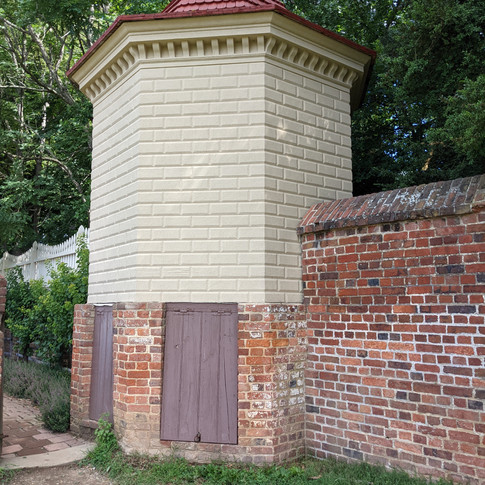Checking Out Washington's Toilets
- Kimberly Worsham
- Jul 3, 2021
- 3 min read
Updated: Jul 7, 2021
Mount Vernon Estate's Necessaries (left to right): entering the necessary, the multi-seat privy; the backdoor for emptying it out, the caskets underneath
In honor of the Fourth of July this year, I traveled to DC. While there, I decided that the best way for FLUSH to commemorate the US’s independence was to look at the sanitation facilities that our key Founding Father, George Washington, used. For a day, we went to the Mount Vernon Estate to see their 18th-century toilets.
We often hear about how people managed their bodily obligations before our sewer systems went online in the mid-to-late-19th century. George Washington’s place may give us a good indication of how to answer that question.
Firstly, the toilets at Mount Vernon were called the necessaries; at the time, they were also called privies. These necessaries were what we now call outhouses – they were seats with holes that dropped our waste into a storage area underneath the privies, sometimes underground. As far as we know, there were two necessaries situated on either side of the estate for everyone to use. From what we understand, everyone could use them, and did – from George Washington to the slaves. Indoor plumbing wasn’t a thing at the time, yet, so people had to trek outside to relieve themselves, provided the weather was decent. When the weather wasn’t decent, or later at night, people would use chamber pots indoors. When Washington or his wife was unwell and stuck in bed, they probably used a particular bedpan for relief. Those enslaved to him would later bring to the necessary to empty.
We visited the estate to see the rebuilt necessaries, tucked away behind some trees and not popular with the touring crowds (we saw no one go over to check them out). However, when we looked into the necessary, we saw three seated holes right next to each other – rather intimately. Does this mean that people were using the toilets together, as they used to in the Roman Empire? We’re not sure, but maybe. It may have been frowned on for people to enjoy each other’s morning evacuations together. On the other hand, maybe it was seen as a way to make the queues shorter and a nice way to socialize? Or maybe it was expected that those enslaved at the estate used the privy together. However, it looks like there may have been another necessary for their use. Some other ideas could have been that they needed to even out the piles of excrement underneath, or maybe it was a matter of preference?
The necessaries were also next to the estate’s garden, where they grew their food. This was the cool thing – George Washington had designed the necessaries for easy excrement removal. They may have been used as fertilizer for nearby fields. In the back of the necessary, we saw the drop door and lifted it to see the caskets where the feces would drop into for emptying.

The Mount Vernon Estate’s placard said, “Not only did [the necessary] provide convenience, but [it] also encouraged the centralized collection of human waste. It fell into large wooden drawers below the seats, which could be easily removed for proper disposal.” This is interesting and also shows us that the idea of tying sanitation with agriculture was more commonplace not so long ago, before our sewered lives.
What about animal manure? They collected animal waste and food scraps for using to fertilize their food gardens and orchards. In a glamorous pile, the dung repository was near the stables (easy access). It probably was the first formal composting structure in the US.

We hope to see more historical sites and learn more about how people used to manage their sanitary needs over time. Thanks to the Mount Vernon Estate for having great educational material available. Have more information for us to share and elaborate on this toilet? Let us know!











Comments